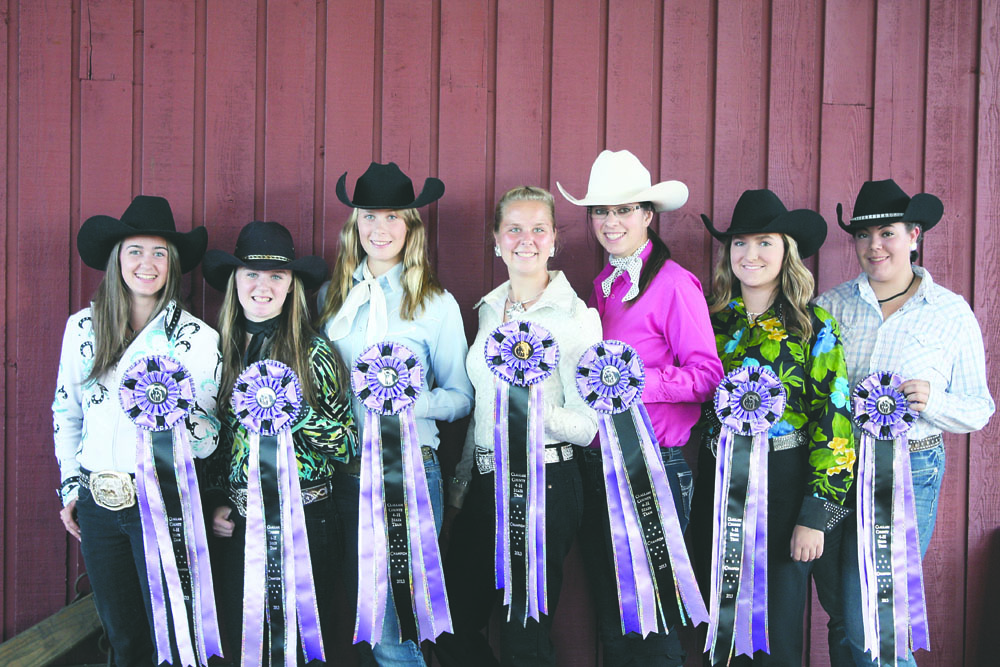LAST TIME, I mentioned how well the intermediate-aged 4-H riders did at the Western Washington State Fair in Puyallup.
Now, it’s the senior performance riders’ turn.
In two weeks, I’ll include the senior games competitors.
In 4-H, each participant is awarded a ribbon: blue ribbons for completing the exercise correctly, red to those who show they understand the exercise but have a minor mistake and white to those who didn’t do the exercise correctly.
In addition, awards are handed out from eighth place to grand champion.
This year’s senior performance state fair riders were Matisen Anders, Marissa Wilson, Cassidy Hodgin, Ciara Gentry, Paige Swordmaker, Matisen Anders, Suzanne Heistand, Holly Cozzolino and Lydia Cornelson.
Results
■ Showmanship: Blue to Holly, Cassidy, Matisen and Ciara; red to Suzanne, Paige, Marissa and Lydia.
■ Huntseat equitation: Blue to Ciara, Cassidy and Holly; red to Paige, Matisen, Suzanne and Lydia.
■ Stockseat equitation: Blue to Holly (who also placed eighth in state), Ciara, Suzanne, Marissa and Paige; red to Matisen.
■ Trail: Blue to Suzanne, Ciara and Paige; red to Cassidy and Matisen.
■ Discipline rail: Blue to Cassidy, Suzanne, Ciara, Holly and Matisen; and white to Paige.
■ Dressage: Red to Lydia and white to Matisen.
■ Bareback: Blue to Paige, Cassidy, Holly and Suzanne, who also won fourth in state; red to Matisen and Ciara.
WAHSET
Port Angeles and Sequim High School equestrian team tryouts have started.
Manon Heistand is continuing on as the Port Angeles coach.
Former Sequim coach Terri Winters retired last year and is replaced by Katie Newton-Salmon.
Newton-Salmon is a familiar sight at local equestrian events.
She grew up competing in 4-H, is a 4-H leader and, for 14 years, has served on the Peninsula Junior Rodeo committee.
As with all high school team sports, participants should already be performing at competition-level.
Thus, to be a member of the equestrian team and compete in Washington State High School Equestrian Team events, those who try out must know how to ride, have some experience in equine competition and own or lease their own horse.
Students from all disciplines — Western and English performance show, rodeo, Western games, dressage, eventing, working cow and driving — are encourage to try out.
The Sequim team includes students from Port Townsend and Chimacum high schools, as those schools currently don’t have their own teams.
Those interested are encouraged to email Heistand (PA) at ganador19@msn.com or Newton-Salmon (Sequim) at klsalmon@yahoo.com.
Caution
Most of us with horses are aware that fast-growing spring and fall grasses, with their high sugar levels, can sometimes cause the onset of laminitis.
And, as I’ve discovered, it can happen after a delivery of freshly cut hay.
Ponies, mini-horses and older horses are especially susceptible.
So what is laminitis?
The simple explanation is inflammation of the laminae or soft tissues between the hoof wall and coffin bone.
In laminitis, the blood flow to the laminae is affected, resulting in inflammation and swelling in the tissues within the hoof, and severe pain.
As laminitis develops, the attachment of the pedal bone to the hoof wall starts to fail, leaving the pedal bone to rotate and point towards the sole and, in the worst cases, to sink right through it.
In severe cases, the coffin bone will even rotate, which can prove fatal.
It’s usually is worse in the front.
Early signs of laminitis include lameness or limping, and hoofs feel very warm to the touch.
The animal will show a reluctance to walk or move and when standing may lean back on to its hind feet in order to relieve the pressure on his front feet.
My Shetland pony, Snowball Express, showed all those signs after a fresh batch of hay was delivered, and it seemed to happen overnight.
The first thing I did was place him in a roughly 20-foot-by-20-foot pen so he couldn’t have access to the rich pasture grass growing this time of year.
Then I went out and bought a low-carbohydrate, low-starch and sugar-complete feed from a local feed store.
I’m following the rule of feeding little and often to help keep his digestive system working correctly.
I’m also adding horse aspirin to his food and the first few days injected with the pain reliever Banamine (available through a vet).
I also take him for short walks throughout the day since he isn’t in an advanced stage where his coffin bone is sinking or rotating.
Starting each walk, he takes a bit of prodding on my part to get him moving, but then as his circulation starts moving better, he starts moving better.
I’ve also been soaking his front legs in a bucket of warm water and Epsom salts, and then briefly running cold water over them to take down the swelling.
Finally, I apply DMSO to his lower legs, hooves and frog. The latter he seems to like the most.
Snow is staying in his pen until he’s completely sound.
Then I will put his grazing muzzle on and allow him to roam the pasture with horse buddies Lacey and Indy.
Reminder: Due to the government shutdown, all national forest and park trails are closed to horseback riding.
Events
■ Saturday, Oct. 19 — Schooling show at Freedom Farm, 493 Spring Road in Agnew. Phone Mary Gallagher at 360-457-4897
■ Noon to 3 p.m. Sunday, Oct. 20 — Cow working class at Freedom Farm. Phone Gallagher at 360-457-4897.
■ 5 p.m. to 8:30 p.m. Thursday, Oct. 24 — Jefferson Equestrian Association fundraiser dinner at the Blue Moose Cafe, 311 Haines Place (Boat Haven), Port Townsend. Learn about current and new projects. Phone Christine Headley at 360-286-9256.
________
Karen Griffiths’ column, Peninsula Horseplay, appears every other Wednesday.
If you have a horse event, clinic or seminar you would like listed, please email Griffiths at kbg@olympus.net at least two weeks in advance. You can also write Griffiths at PDN, P.O. Box 1330, Port Angeles, WA 98362.

